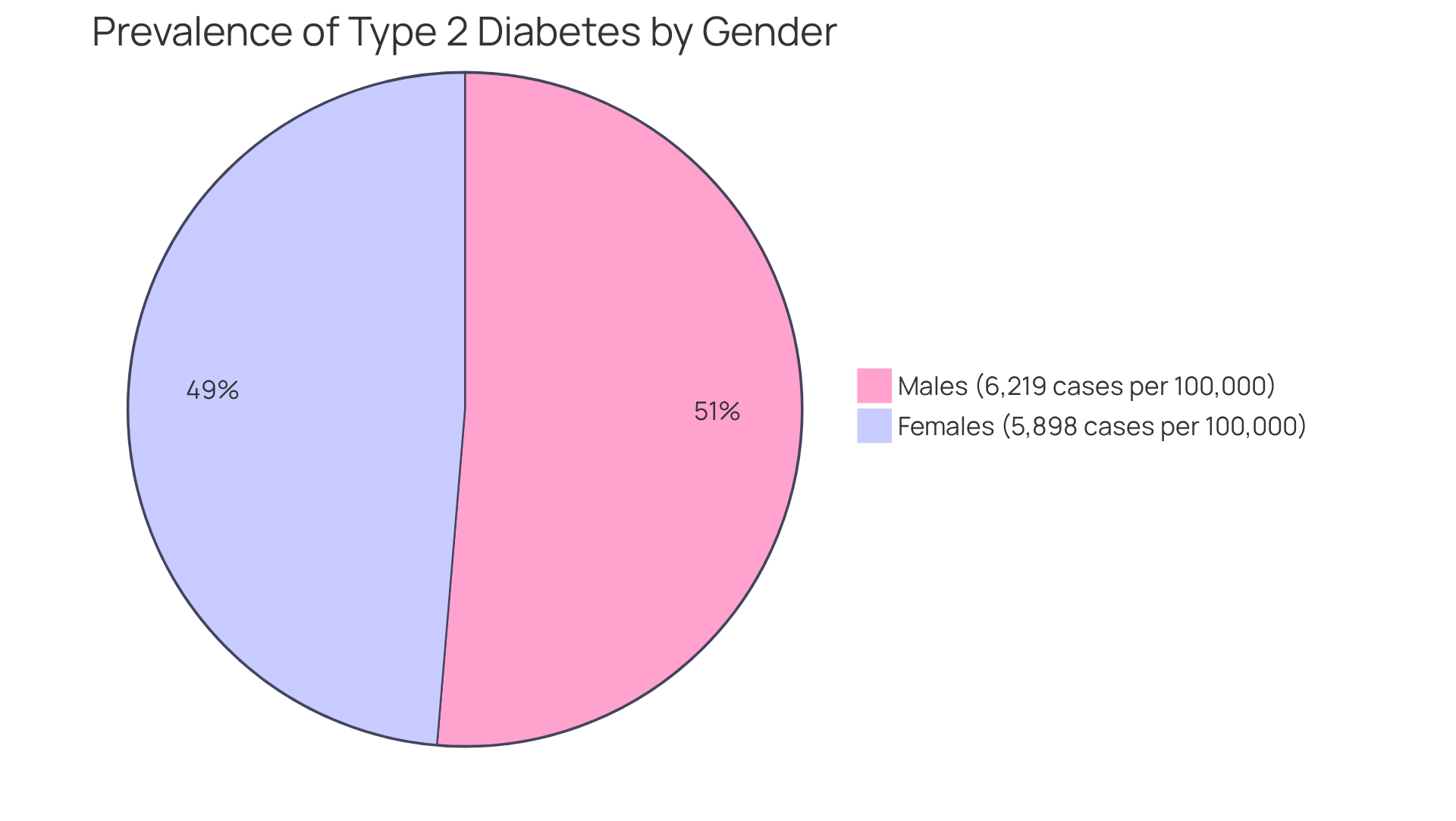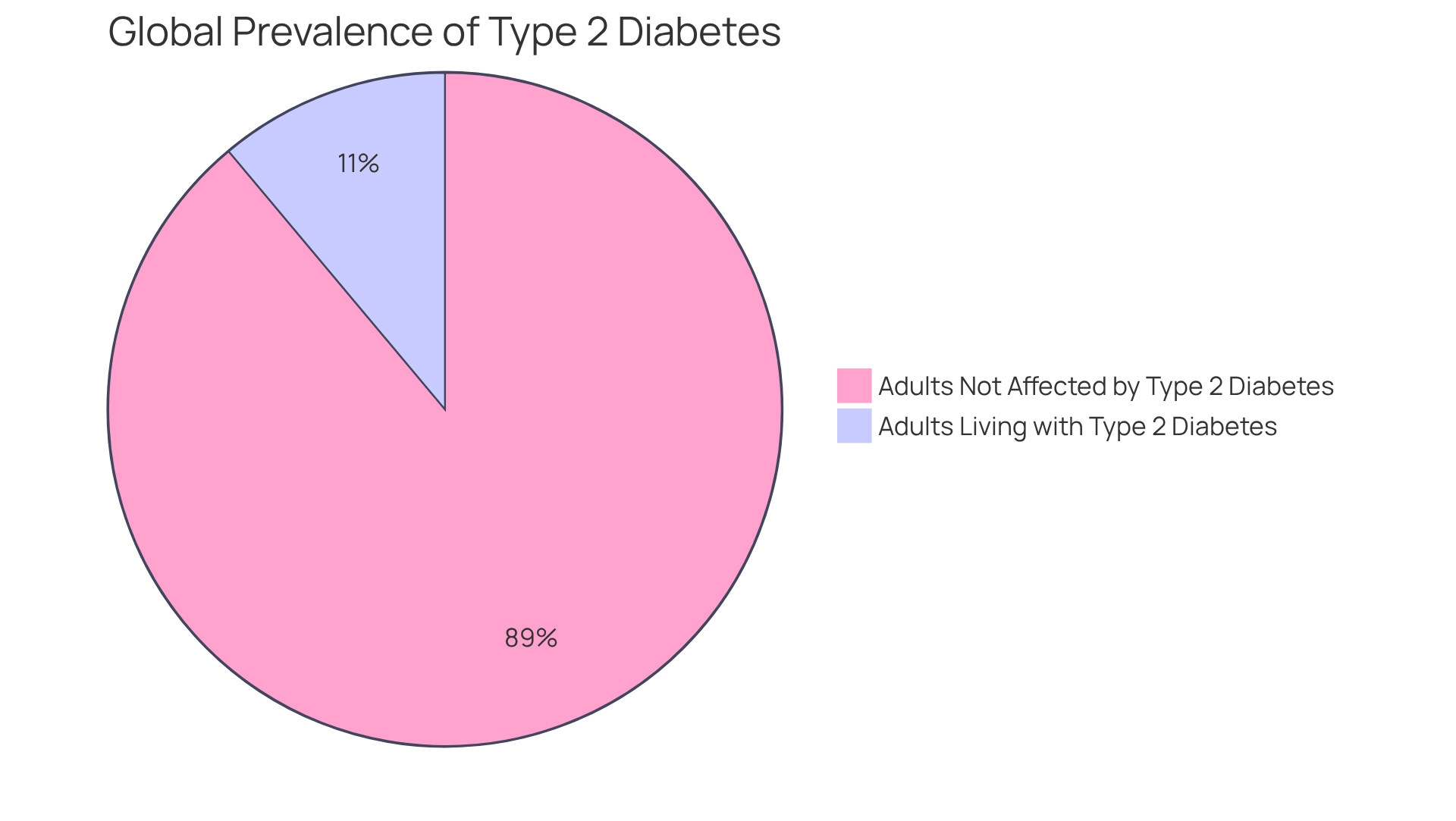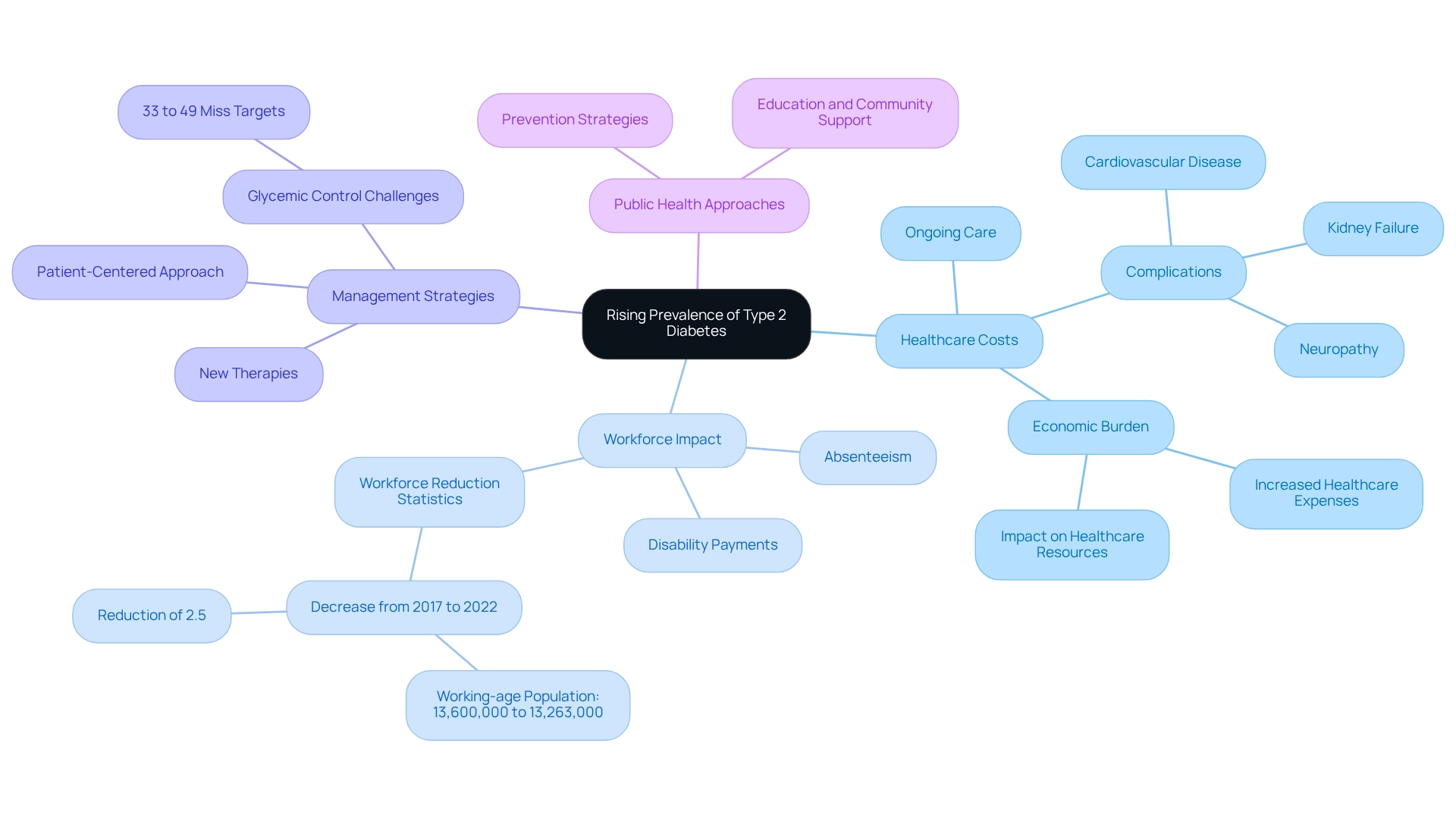Overview
The article highlights a pressing concern: the global prevalence of Type 2 diabetes, affecting approximately 11.1% of the adult population—around 589 million individuals. This alarming statistic has quadrupled since 1990, largely due to rising obesity rates and lifestyle changes. It's understandable to feel overwhelmed by these numbers, but it's crucial to recognize the urgent need for public health initiatives focused on prevention and management. Together, we can work to mitigate the impact of this condition on healthcare systems worldwide.
You're not alone in this journey. As we navigate through these challenges, it's essential to seek support and resources that can help you manage your health effectively. Remember, we are here to support you every step of the way.
Introduction
The rising tide of Type 2 Diabetes is a pressing concern that affects millions globally, demanding urgent attention from health professionals and policymakers alike. It's understandable to feel overwhelmed by the statistics—approximately 589 million individuals are currently living with diabetes. This chronic condition not only impacts individual health but also stretches its implications across healthcare systems, economies, and communities at large.
As the prevalence of this condition continues to soar, alarming trends emerge, underscoring the urgent need for effective public health strategies. This article delves into the critical statistics and trends surrounding Type 2 Diabetes, examining its prevalence, the factors contributing to its rise, and the far-reaching consequences for society. By understanding the complexities of this epidemic, we can better navigate the challenges ahead.
You're not alone in this journey. Together, we can work toward implementing targeted interventions to combat this growing health crisis. We are here to support you every step of the way.
Define Prevalence of Type 2 Diabetes
The prevalence of Type 2 diabetes refers to the proportion of people within a population who are impacted by this condition at a specific moment. This metric is typically expressed as a percentage or ratio, illustrating the extent of the disease across various demographics and geographic regions. Understanding the prevalence of type 2 diabetes worldwide is crucial for effective public health planning and resource allocation, as it highlights the disease's impact on healthcare systems and communities. Notably, males exhibit a slightly higher prevalence than females, with 6,219 cases compared to 5,898 cases per 100,000 individuals. This condition is characterized by insulin resistance and is frequently linked to obesity, sedentary lifestyles, and genetic predispositions. It's understandable to feel overwhelmed by these statistics, but remember, you're not alone in this journey.
As a result, the occurrence of Type 2 diabetes acts as an essential marker of wider health patterns, highlighting the necessity for public policies and funding focused on prevention initiatives. Furthermore, research indicates that impaired glucose tolerance (IGT) and impaired fasting glycaemia (IFG) are critical risk factors for developing Type 2 diabetes, representing a significant transition phase. This highlights the importance of lifestyle interventions and ongoing monitoring to mitigate progression, particularly as the prevalence of type 2 diabetes worldwide continues to rise due to unhealthy eating and sedentary lifestyles, making it increasingly essential to understand this epidemic effectively. T2DSolutions aims to provide educational resources and community support to help newly diagnosed patients navigate these challenges and manage their condition effectively. We are here to support you every step of the way.

Examine Global Statistics and Trends
Recent data indicates that the prevalence of type 2 diabetes worldwide has reached concerning levels. The International Diabetes Federation (IDF) estimates that roughly 11.1% of the adult population, equating to about 589 million individuals, are presently living with this illness, reflecting the prevalence of type 2 diabetes worldwide. Notably, the prevalence of type 2 diabetes worldwide accounts for over 90% of these cases.
It's understandable to feel alarmed by the World Health Organization (WHO) highlighting a staggering increase in the prevalence of type 2 diabetes worldwide, which has more than quadrupled since 1990, escalating from 7% to 14% among adults. Projections suggest that by 2025, the prevalence of type 2 diabetes worldwide could surge by 59.7%, primarily driven by rising obesity rates and lifestyle changes. This trend is particularly pronounced in low- and middle-income countries (LMICs), where the prevalence of type 2 diabetes worldwide is rapidly escalating, underscoring a global health crisis that necessitates immediate intervention. In Saudi Arabia, for example, the Disability-Adjusted Life Years (DALY) count was reported at 391 thousand, emphasizing the substantial effect of this condition in particular areas.
Successful interventions in LMICs have shown the potential for effective control of blood sugar. For instance, the WHO's Global Diabetes Compact, initiated in 2021, seeks to lower the risk of diabetes-related issues and guarantee fair access to quality treatment and care. This initiative has created a structure for nations to prioritize the prevention and control of this condition, resulting in enhanced health outcomes and focused interventions against it and its risk factors. As Sir Zumla, a UK-NIHR Senior Investigator, notes, 'The prevalence of type 2 diabetes worldwide is a pressing global health challenge that requires coordinated efforts to address.'
Furthermore, understanding the long-term effects of high blood sugar levels is crucial. High blood sugar can lead to severe complications affecting various organs, particularly the kidneys, and is linked to cardiovascular issues, increasing the risk of heart failure and stroke. These insights highlight the significance of efficient control of blood sugar levels to avert severe health issues and enhance overall health system efficacy worldwide. A research titled "Diabetes and Global Health System Performance" emphasizes that improving care for the condition is crucial for enhancing overall health system effectiveness and decreasing the burden of related complications.
In summary, the trends in the prevalence of type 2 diabetes worldwide since 1990 reveal a pressing need for comprehensive strategies to address this growing epidemic, particularly among vulnerable populations. By promoting community involvement and offering available resources, T2DSolutions is dedicated to empowering individuals and healthcare providers in their health journey. T2DSolutions will act as an essential resource center, providing educational materials and assistance to help navigate the intricacies of glucose regulation. Furthermore, fact sheets concerning this condition will be issued on 14 November 2024, offering timely resources for those looking to improve their comprehension and management of the illness.

Analyze Implications of Rising Prevalence Rates
The rising prevalence of type 2 diabetes worldwide presents significant challenges for healthcare systems. As more individuals are diagnosed with this condition, healthcare expenses continue to increase due to the need for ongoing medical care, medications, and regular monitoring. Complications related to blood sugar regulation, such as cardiovascular disease, kidney failure, and neuropathy, add to the strain on healthcare resources.
It's understandable to feel concerned about the economic impact; studies show that individuals aged 18-65 with diabetes are 1.8 percentage points more likely to be out of the workforce compared to their non-diabetic peers. This trend not only affects personal livelihoods but also leads to higher absenteeism and disability payments, highlighting the urgent need for effective oversight strategies. The working-age adult population has decreased from 13,600,000 in 2017 to 13,263,000 in 2022, a reduction of 2.5%, further emphasizing the economic effects of this condition on workforce involvement.
Healthcare expenses related to Type 2 Diabetes care are substantial. Many healthcare resources are dedicated to addressing complications associated with this illness. Despite advancements in managing blood sugar levels, specialists note that a significant portion of individuals—between 33% and 49%—do not meet their glycemic, blood pressure, or cholesterol goals. This shortfall underscores the need for effective oversight and support.
Fortunately, new therapies for blood sugar regulation are being developed to address the unmet needs of patients, which could be vital in enhancing management strategies. On a broader scale, the growing prevalence of type 2 diabetes worldwide calls for comprehensive public health approaches that prioritize prevention, education, and community support. Tackling these challenges is essential not only for improving personal health outcomes but also for ensuring the long-term sustainability of healthcare systems worldwide.
As highlighted in the case study regarding therapeutic agents for managing blood sugar conditions, a patient-centered approach that considers individual traits and treatment goals is crucial for improving outcomes and alleviating the economic burden of this rising epidemic. Remember, you're not alone in this journey. T2DSolutions aims to be a pivotal resource, providing education and support to newly diagnosed patients, helping you navigate your diabetes management effectively.

Conclusion
The increasing prevalence of Type 2 Diabetes represents a significant global health crisis that demands immediate and coordinated action. With approximately 589 million individuals affected and projections indicating a continued rise, it is clear that the implications extend far beyond individual health. The burden on healthcare systems is substantial, with rising costs associated with treatment, complications, and loss of workforce productivity.
Understanding the statistics and trends surrounding Type 2 Diabetes is essential for developing effective public health strategies. The alarming rise in cases, particularly in low- and middle-income countries, underscores the need for targeted interventions and community support. Initiatives like the WHO's Global Diabetes Compact highlight the importance of equitable access to quality care and prevention programs.
Ultimately, addressing Type 2 Diabetes requires a multifaceted approach that prioritizes prevention, education, and ongoing management. By fostering awareness and providing resources, individuals and healthcare providers can work together to combat this epidemic. Remember, you are not alone in this journey. As we navigate the complexities of diabetes management, collective efforts will be vital in creating a healthier future and alleviating the strain on healthcare systems worldwide.
Frequently Asked Questions
What does the prevalence of Type 2 diabetes refer to?
The prevalence of Type 2 diabetes refers to the proportion of people within a population who are impacted by this condition at a specific moment, typically expressed as a percentage or ratio.
Why is understanding the prevalence of Type 2 diabetes important?
Understanding the prevalence of Type 2 diabetes is crucial for effective public health planning and resource allocation, as it highlights the disease's impact on healthcare systems and communities.
Are there differences in the prevalence of Type 2 diabetes between genders?
Yes, males exhibit a slightly higher prevalence of Type 2 diabetes than females, with 6,219 cases compared to 5,898 cases per 100,000 individuals.
What are some key characteristics of Type 2 diabetes?
Type 2 diabetes is characterized by insulin resistance and is frequently linked to obesity, sedentary lifestyles, and genetic predispositions.
What are critical risk factors for developing Type 2 diabetes?
Impaired glucose tolerance (IGT) and impaired fasting glycaemia (IFG) are critical risk factors for developing Type 2 diabetes, representing a significant transition phase.
What lifestyle factors contribute to the rising prevalence of Type 2 diabetes?
Unhealthy eating and sedentary lifestyles contribute to the rising prevalence of Type 2 diabetes worldwide.
How does T2DSolutions support newly diagnosed patients?
T2DSolutions aims to provide educational resources and community support to help newly diagnosed patients navigate the challenges of managing their condition effectively.



